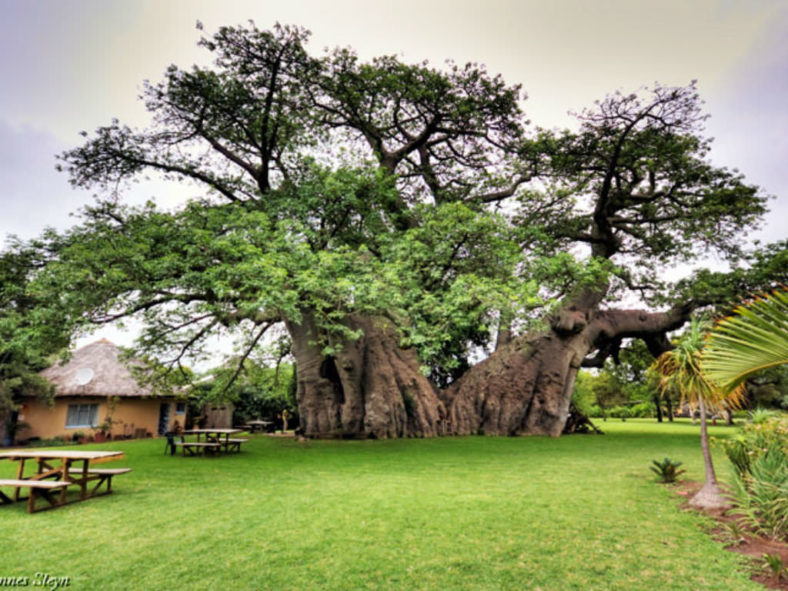The giant Baobab, a symbol of life on the African plains, belongs to the genus Adansonia, which comprises nine species. Only two species, Adansonia digitata and Adansonia kilima, are native to the African mainland, while six of their relatives are found in Madagascar and one in Australia. Although the Baobab's genus is small, the tree is quite the opposite.
This plant is the monster of the African bush, a vast fleshy giant that looms over the Acacia shrubland, waving its Medusa-like branches above a bulbous body. It may not be as tall as the coast redwood, but its vast bulk makes it a strong contender for the world's largest tree. Adansonia digitata can reach 82 feet (25 m) in height and 46 feet (14 m) in diameter.
Baobabs are often referred to as upside-down trees thanks to the root-like appearance of their tangled branches. They are found throughout the African continent, although their range is limited by their preference for drier, less tropical climates. They have been introduced overseas as well and can now be found in countries like India, China, and Oman. Baobabs are now known to exceed 1,500 years of age.
The Sunland Baobab
The widest Baobab (Adansonia digitata) in existence is thought to be the Sunland Baobab, located in Modjadjiskloof, Limpopo Province. This breathtaking specimen stands 62 feet (19 m) tall and has a diameter of 34.9 feet (10.6 m). At its widest point, the Sunland Baobab's trunk has a circumference of 109.5 feet (33.4 m).

The tree has had plenty of time to reach its record-breaking width, with carbon dating giving it an approximate age of around 1,700 years. However, after reaching 1,000 years, Baobabs began to hollow out from the inside, and the owners of the Sunland Baobab made the most of this natural feature by creating a bar and wine cellar within its interior.
The Tree of Life
The Baobab has many valuable properties, which explains why it is widely known as the Tree of Life. It behaves like a giant succulent, and up to 80% of the trunk is water. San Bushmen used to rely on trees as a valuable source of water when the rains failed and the rivers dried up. A single tree can hold up to 1,189 gallons (4,500 l), while the hollow center of an old tree can also provide valuable shelter.
The bark and flesh are soft, fibrous, and fire-resistant, and can be used to weave rope and cloth. Baobab products are also used to make soap, rubber, and glue, while the bark and leaves are used in traditional medicine. The Baobab is also a life-giver for African wildlife, often creating its own ecosystem. It provides food and shelter for many species, from the tiniest insect to the mighty African elephant.
A Modern Superfruit
Baobab fruit resembles a velvet-covered oblong gourd, filled with large black seeds and surrounded by tart, slightly powdery pulp. Native Africans often refer to the Baobab as the Monkey-bread tree and have known its health benefits for centuries. Young leaves can be cooked and eaten as an alternative to spinach, while the fruit pulp is often soaked and then blended into a drink.
Recently, the Western world has hailed the Baobab fruit as the ultimate superfruit, thanks to its high levels of calcium, iron, potassium, and Vitamin C. Some reports state that the fruit's pulp has almost 10 times the Vitamin C content of an equivalent serving of fresh oranges. In addition, it contains 50% more calcium than spinach and is recommended for improving skin elasticity, supporting weight loss, and enhancing cardiovascular health.
Legends
Many stories and traditions surround the Baobab. Along the Zambezi River, many tribes believe that the Baobab once grew upright but considered itself so much better than the lesser trees around it that, eventually, the gods decided to teach the Baobab a lesson. They uprooted and planted it upside down to stop its boasting and teach the tree humility.
In other areas, specific trees have stories attached to them. Zambia's Kafue National Park is home to a huge specimen known locally as Kondanamwali (the tree that eats maidens). According to legend, the tree fell in love with four local girls, who shunned the tree and sought human husbands instead. In revenge, the tree pulled the maidens into its interior and kept them there forever.
Elsewhere, it is believed that washing a young boy with the Baobab tree bark will help him grow strong and tall. Others hold the tradition that women living in a Baobab area are more fertile than those living in an area without Baobabs. In many places, the enduring giant trees are recognized as symbols of community and gathering places.
The Order of the Baobab is a South African civilian national honor instituted in 2002. It is awarded annually by the South African president to citizens for distinguished service in business and the economy, science, medicine, technological innovation, or community service. It was named in recognition of the Baobab's endurance and cultural and environmental importance.
Source: thoughtco.com
Links
- Back to genus Adansonia
- Succupedia: Browse succulents by Scientific Name, Common Name, Genus, Family, USDA Hardiness Zone, Origin, or cacti by Genus